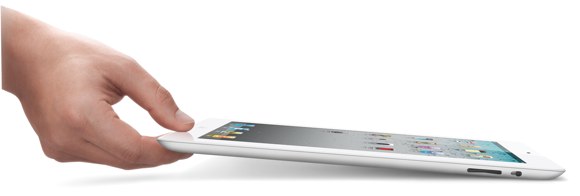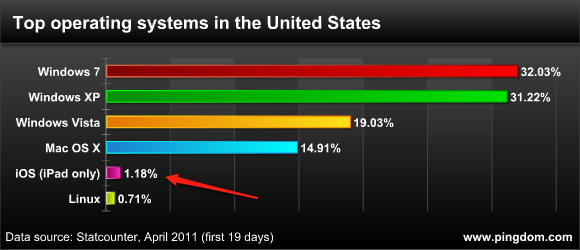
We noticed an interesting thing the other day that we’d like to share with you. However, if you’re a Linux enthusiast, you may want to stop reading now…
These are the operating system stats for April for the United States:

These market share numbers are from Statcounter and are based on visitor statistics averaged from 3+ million websites. In other words, they represent computers used to access the Web. Mobile phones and other small-screen devices are not included.
In other words, the iOS market share you see in the chart is only for iPad. It does not include the iPhone or iPod Touch. We’ve verified this with Statcounter, just to be entirely sure.
Not only is iPad now so widely used that it shows up in this list, iOS for iPad has managed to pass Linux as a “desktop OS” (we use quotes, because tablets will probably soon make up their own category). In fact, it passed Linux sometime around December. Not bad for a device that was launched just back in April of 2010.
Other “iPad nations”
The iPad has reached this level of market penetration in several other countries as well. For example:
- In the United Kingdom, iPad’s iOS makes up 0.94%, versus 0.74% for Linux.
- In Canada, iPad’s iOS makes up 0.91%, versus 0.76% for Linux.
- In Australia, iPad’s iOS makes up 1.19%, versus 0.66% for Linux.
- In the Netherlands, iPad’s iOS makes up 1.16%, versus 0.81% for Linux.
No one can say that Apple’s little tablet isn’t popular these days. And this was just year one for the iPad.
How fast did the iPad reach these levels?
The wifi model of the first iPad launched on April 3, 2010, and the 3G version followed a few weeks later. Here’s the iPad’s “desktop OS market share,” month by month since then:

The iPad seems to have been a popular gift this Christmas, considering how usage increased in connection with the holiday season.
This blog’s perspective
Just for fun, we also had a look at our own blog stats. They’re from Google Analytics and represent “visits” so the metric is slightly different, but it’s interesting nonetheless.
In the past 30 days, 1.9% of the visits were from iPads. Interestingly, a full 3.3% were from iPhones, and 1% from iPods. So iOS devices as a group account for more than 6% of our visits. Android accounts for 1.6%.
Linux computers still beat the iPad among our readers, though, with 5.88% of the visits, perhaps not surprising since we tend to have a pretty tech savvy audience (not to say that iPad users can’t be tech savvy, just that the odds for people using Linux becomes slightly higher).
Still, that’s just for one site, ours. Different sites have different kinds of visitors. The Statcounter numbers are averaged for 3+ million websites so it will give a more accurate picture than looking at any one site.



























